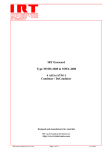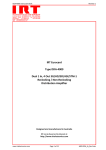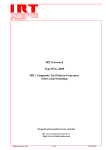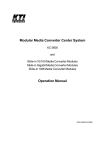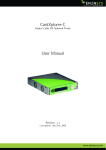Download MMM-4711 & MMX-4711 User Manual
Transcript
MMM-4711 & MMX-4711 4 ASI to ASI Combiner / DeCombiner User Manual IRT Electronics Pty Ltd | www.irtelectronics.com Revision 04 MMM-4711 & MMX-4711 4 ASI TO ASI COMBINER / DE-COMBINER Revision History: Revision 00 Date 15/09/2008 By AL Change Description Original Issue. 01 28/01/2009 AL Data connections added. 02 30/01/2009 AL Corrections to input data rate and power ratings. 03 05/02/2010 AL 04 16/08/2012 AL SNMP functions and switch setting changes added to MMM and MMX cards. ‘S’ version card variations (MMM-4711-S & MMX-4711-S) incorporated into standard instruction book. SW4-5 DIP switch option added to MMM-4711 to allow Minor Alarm on loss of any ‘enabled’ input. Applicable to: Firmware versions ≥ MMM-4711i6A & MMX-4711i6B Firmware versions ≥ MMM-4711i6C & MMX-4711i6B Firmware versions ≥ MMM-4711i6C & MMX-4711i6B Firmware versions ≥ MMM-4711i6ES1V0 & MMX-4711i6ES1V1 Firmware versions ≥ MMM-4711i6FS1V1 & MMX-4711i6GS1V3 IRT Electronics Pty Ltd | www.irtelectronics.com Page 2 of 20 Revision 04 MMM-4711 & MMX-4711 USER MANUAL Table of Contents: Section Page Revision History Operational Safety General Description Technical Specifications Configuration Installation Connections Front and rear layouts SNMP – What Is It? MMM-4711 & MMX-4711 SNMP Functions Maintenance & Storage Warranty & Service Equipment return 2 4 5 6 7 9 10 15 16 18 20 20 20 This instruction book applies to units fitted with firmware MMM-4711i6FS1V1 and MMX-4711i6GS1V3. IRT Electronics Pty Ltd | www.irtelectronics.com Page 3 of 20 Revision 04 MMM-4711 & MMX-4711 OPERATIONAL SAFETY WARNING Operation of electronic equipment involves the use of voltages and currents that may be dangerous to human life. Note that under certain conditions dangerous potentials may exist in some circuits when power controls are in the OFF position. Maintenance personnel should observe all safety regulations. Do not make any adjustments inside equipment with power ON unless proper precautions are observed. All internal adjustments should only be made by suitably qualified personnel. All operational adjustments are available externally without the need for removing covers or use of extender cards. IRT Electronics Pty Ltd | www.irtelectronics.com Page 4 of 20 Revision 04 MMM-4711 & MMX-4711 GENERAL DESCRIPTION BLOCK DIAGRAM MMM-4711 & MMX-4711 SIGNAL PATH ASI-1 I/P ASI-2 I/P ASI-3 I/P MMM-4711 Mux 2 x ASI & Outputs Signal Processing ASI Input MMX-4711 Signal Processing & De-Mux ASI-4 I/P DATA I/P ASI-1 O/P ASI-2 O/P ASI-3 O/P ASI-4 O/P SNMP SNMP DATA O/P The MMM-4711 and MMX-4711 are part of a family of data transcoders for converting between the commonly used MPEG2 Transport Stream formats for video distribution in the broadcast industry. With the MMM-4711 up to four ASI signals can be combined together and converted into a single ASI signal with a settable output payload rate. 1 The sum of the ASI input payload rates can be anything up to approximately 0.9 x the set ASI output payload rate. Inputs may be 188 or 204 byte packet lengths, burst or continuous, and may have energy dispersal scrambling, 1 interleaving and/or Reed Solomon bytes included. An individual input may be up to 0.9 x the full set ASI output payload rate if the other inputs are unused. The output ASI stream is a valid stream, which complies with all facets of ETR290. 1 Provided the total sum of the ASI inputs does not exceed approximately 0.9 x the set output rate, units can be cascaded to increase the number of ASI inputs into a single ASI output. The MMX-4711 separates the combined ASI signal back into the original four ASI signals (at their original rates and without any modification of the stream, or stream timing). If more than one MMM-4711 has been cascaded then the MMX-4711’s cascade in the reverse order. Inputs are automatically equalised for lengths of up to 250m of Belden 8281 or equivalent cable. Front panel indication and relay alarm on the MMM-4711 transmitter shows if there is an input data rate violation. Corresponding alarm on the MMX-4711 receiver shows a loss of ASI input. The MMM-4711 and MMX-4711 are designed to fit IRT’s standard Eurocard frames and may be used alongside any other of IRT’s analogue or digital Eurocards. Standard features: • • • • • Up to 4 ASI streams on one ASI link. Units may be cascaded to increase the number of ASI inputs. Recovers transmitted ASI signal without any added PCR jitter and with minimal user setup Maintains original ASI rate, packet size & coding (energy dispersal scrambling, interleaving or Reed Solomon bytes). Suitable for Single Frequency Networks (SFN). NOTE: 1 0.95 x with 188 byte inputs, 0.88 x with 204 byte inputs. IRT Electronics Pty Ltd | www.irtelectronics.com Page 5 of 20 Revision 04 MMM-4711 & MMX-4711 TECHNICAL SPECIFICATIONS MMM-4711: Inputs: Type 1 Maximum Data Rate per channel Equalisation 4 x ASI-C 75Ω, 800 mVp-p, BNC connector. Sum total less than 0.95 x selected output rate with 188 byte signals, or less than 0.88 x selected output rate with 204 byte signals. Automatic, better than 200 metres at 270 Mb/s for Belden 8281 or equivalent cable. Type 2 RS232 Uni directional data input (maximum 38k4 baud). Output: Type Payload Rate Switch Settable SNMP Settable Alarm Output: MAJOR 2 x ASI-C 75Ω, 800 mVp-p, BNC connector, 188 byte, Burst (Packet) Mode. 10 Mb/s; 31.672 Mb/s; 34.368 Mb/s (equivalent to E3 rate); 41.227 Mb/s; 44.736 Mb/s (equivalent to Unframed DS3 rate); 44.210Mb/s (equivalent to Framed DS3 rate); 80 Mb/s; 90 Mb/s; 110 Mb/s; 148 Mb/s (suited for STM-1); and 213 Mb/s. Between 1Mb/s & 213Mb/s. 2 Open circuit on sum of ASI input payload rates in excess of set ASI output payload rate, or loss of power. 2 Open circuit on either no valid input ASI streams present or no valid input on any individual SNMP enabled input present, or loss of power. MINOR MMX-4711: Input: Type Equalisation ASI-C 75Ω, 800 mVp-p, BNC connector. (Equivalent to MMM-4711 output rate). Automatic, better than 250 metres at 270 Mb/s for Belden 8281 or equivalent cable. Outputs: Type 1 Data Rate 4 x ASI-C 75 Ω, 800 mVp-p, BNC connector, Burst (Packet) Mode. Same as MMM-4711 input rate. Type 2 RS232 Uni directional data output. Alarm Output: MAJOR MINOR Open circuit on no valid ASI input present, or loss of power. 2 Open circuit on no valid output ASI streams present, or loss of power. Power Requirements: Voltage Power consumption 28 Vac CT (14-0-14) or ±16 Vdc. MMM-4711 < 5VA, MMX-4711 < 4VA. 2 Other: Temperature range Mechanical Finish Dimensions NOTE: 2 Front panel Rear assembly 0 - 50° C ambient. For mounting in IRT 19" rack chassis with input, output and power connections on the rear panel. Grey background, black lettering & red IRT logo. Detachable silk-screened PCB with direct mount connectors to Eurocard and external signals. 6 HP x 3 U x 220 mm IRT Eurocard. For S version cards (MMM-4711-S and MMX-4711-S) output alarms switch to Ground rather than Open Circuit. Due to our policy of continuing development, these specifications are subject to change without notice. IRT Electronics Pty Ltd | www.irtelectronics.com Page 6 of 20 Revision 04 MMM-4711 & MMX-4711 CONFIGURATION MMM-4711: The only user settings on the MMM-4711 are on the DIP switch SW4 as shown below: ON 1 2 3 4 5 6 7 8 SW4-1 SW4-2 - ASI Output rate (see below). SW4-3 SW4-4 3 SW4-5 - Minor Alarm configuration . SW4-6 - Data input select. SW4-7 - Use SNMP settings. SW4-8 - Disable Major & Minor SNMP alarms. SW4-4 SW4-3 SW4-2 SW4-1 Output ASI Payload Rate OFF OFF OFF OFF 34.368 Mb/s (equivalent to E3 rate). OFF OFF OFF ON 44.736 Mb/s (equivalent to DS3 rate). OFF OFF ON OFF 44.209 Mb/s (equivalent to DS3 framed rate). OFF OFF ON ON 148 Mb/s (suited for STM-1). OFF ON OFF OFF 10 Mb/s. OFF ON OFF ON 80 Mb/s. OFF ON ON OFF 110 Mb/s. OFF ON ON ON 213 Mb/s (full rate). ON OFF OFF OFF 90 Mb/s. ON OFF OFF ON 31.672 Mb/s (equivalent to 188/204 x E3 rate). ON OFF ON OFF 41.227 Mb/s (equivalent to 188/204 x DS3 rate). ON OFF ON ON 213 Mb/s (full rate). ON ON OFF OFF 213 Mb/s (full rate). ON ON OFF ON 213 Mb/s (full rate). ON ON ON OFF 213 Mb/s (full rate). ON ON ON ON 213 Mb/s (full rate). SW4-5 OFF Minor Alarm on no valid input ASI streams present on all four inputs. 3 ON Minor Alarm on no valid input ASI stream present on any enabled input. SW4-6 OFF Data input disabled. 4 ON Data input enabled . Sw4-7 OFF Uses DIP switch settings. ON Uses SNMP settings. 5 SW4-8 OFF Enable major and minor SNMP alarms to the frame Agent (CDM card) . 5 ON Disable major and minor SNMP alarms to the frame Agent (CDM card) . NOTE: 3 Not applicable for firmware versions < i6F. “Channel enabled” or “Channel disabled” is set via SNMP. If less than the four inputs are to be used, unused inputs must be disabled else Minor Alarm will always be activated with SW4-5 set to the ON position. Else SW5-5 should be left in the OFF position. 4 With “Data input” enabled maximum sum of ASI inputs is reduced by 0.6Mb. With “Data input” disabled front panel “Data LED” is also disabled. 5 When using TRAPS via SNMP, depending on how system is set up, in order to avoid double reporting of alarms via the MMM-4711 card itself and the CDM card (SNMP Agent) of the frame, major and minor SNMP alarms that are reported to the CDM card of the frame can be disabled. IRT Electronics Pty Ltd | www.irtelectronics.com Page 7 of 20 Revision 04 MMM-4711 & MMX-4711 MMX-4711: The only user settings on the MMX-4711 are on the DIP switch SW4 as shown below: ON 1 2 3 4 5 6 7 8 SW4-1 - Not used. SW4-2 - Not used. SW4-3 - Not used. SW4-4 - Not used. SW4-5 - Not used. SW4-6 - Not used. SW4-7 - Not used. 6 SW4-8 - Disable Major & Minor SNMP alarms . SW4-1 Not used. SW4-2 Not used. SW4-3 Not used. SW4-4 Not used. SW4-5 Not used. SW4-6 Not used. SW4-7 Not used. 6 SW4-8 OFF Enable major and minor SNMP alarms to the frame Agent (CDM card) . 6 ON Disable major and minor SNMP alarms to the frame Agent (CDM card) . NOTE: 6 When using TRAPS via SNMP, depending on how system is set up, in order to avoid double reporting of alarms via the MMX-4711 card itself and the CDM card (SNMP Agent) of the frame, major and minor SNMP alarms that are reported to the CDM card of the frame can be disabled. IRT Electronics Pty Ltd | www.irtelectronics.com Page 8 of 20 Revision 04 MMM-4711 & MMX-4711 INSTALLATION Pre-installation: Handling: This equipment may contain or be connected to static sensitive devices and proper static free handling precautions should be observed. Where individual circuit cards are stored, they should be placed in antistatic bags. Proper antistatic procedures should be followed when inserting or removing cards from these bags. Power: AC mains supply: Ensure that operating voltage of unit and local supply voltage match and that correct rating fuse is installed for local supply. DC supply: Ensure that the correct polarity is observed and that DC supply voltage is maintained within the operating range specified. Earthing: The earth path is dependent on the type of frame selected. In every case particular care should be taken to ensure that the frame is connected to earth for safety reasons. See frame manual for details. Signal earth: For safety reasons a connection is made between signal earth and chassis earth. No attempt should be made to break this connection. Installation in frame or chassis: See details in separate manual for selected frame type. IRT Electronics Pty Ltd | www.irtelectronics.com Page 9 of 20 Revision 04 MMM-4711 & MMX-4711 Connections: MMM-4711: ASI Inputs: Four ASI inputs each with any payload rate up to a maximum combined total payload of 0.95 x the settable ASI output payload rate, for 188 byte input signals, or 0.88 x the settable output payload rate for 204 byte input signals (see Configuration section of this manual). That is, Combined Total Payload = ASI 1 rate + ASI 2 rate + ASI 3 rate + ASI 4 rate ≤ 0.95 x Set Output Payload Rate, for 188 byte input signals, or ≤ 0.88 x Set Output Payload Rate, for 204 byte input signals. WARNING: If the total maximum input payload rate is exceeded, all ASI channels will be corrupted. With “Data input” enabled (SW4-6 ON) maximum sum of ASI inputs reduces by 0.6Mb. ASI inputs may be of 188 or 204 byte packet length and may have energy dispersal scrambling / interleaving and Reed Solomon bytes if desired. Streams with conditional access may also be passed. ASI inputs are by BNC connectors each terminated in 75Ω. Input cable equalisation is automatic for up to 250m of high quality 75Ω coaxial cable (Belden 8281 or equivalent). No adjustments are required. ASI Outputs: Two identical ASI outputs are provided by BNC connectors with a 75Ω characteristic output impedance. The output ASI payload rate is set via a dual in line switch (SW4), see Configuration section of this manual. Only high quality 75Ω coaxial cable (Belden 8281 or equivalent) should be used. No adjustments are required, but cable must be terminated in 75Ω at the connected load. Alarm Outputs: Two relay alarm output states are provided via a phoenix style 4-pin plug. Pin 3 is designated as Major, pin 4 is designated as Minor, and both pins 1 & 2 are ground. Both alarms are referenced to ground. Alarm conditions are as follows: 7 Major switch to Open Circuit on sum of ASI input payload rates in excess of maximum allowable; 7 Minor switch to Open Circuit on either no valid input ASI streams present or no valid input on any individual SNMP enabled input present – dependent upon SW4-5 DIP switch setting. 7 Both Major and Minor alarms switch to Open Circuit on power failure. When using TRAPS via SNMP, depending on how system is set up, in order to avoid double reporting of alarms via the MMM-4711 card itself and the CDM card (SNMP Agent) of the frame, major and minor SNMP alarms that are reported to the CDM card of the frame can be disabled with DIP switch SW4-8 set to ON. NOTE: 7 For S version cards (MMM-4711-S) output alarms switch to Ground rather than Open Circuit. IRT Electronics Pty Ltd | www.irtelectronics.com Page 10 of 20 Revision 04 MMM-4711 & MMX-4711 Cascading: It is possible to cascade the output from one or more MMM-4711’s into the inputs of another MMM-4711 provided the total sum of the ASI inputs of the final MMM-4711 does not exceed its set ASI output rate. For example, it is possible to have, say, four 2Mb/s ASI streams combined together with one MMM-4711 with its output rate set to 10Mb/s and use this combined 10Mb/s ASI stream and feed it into one of the input ports of another MMM-4711, thus allowing more ASI streams to be combined at the output of the second MMM-4711. It is even possible to cascade this output into yet another MMM-4711, providing that the sum of the inputs into this unit does not exceed its set output ASI rate. At the receiving end the MMX-4711’s are arranged in the reverse order to give the original ASI streams. For example: MMM (1) ASI 1 ASI 2 ASI 3 ASI 4 1 2 3 4 MMX (2) MMM (3) OUT 1 2 3 4 MMX (1) OUT IN MMM (2) ASI 5 ASI 6 ASI 7 ASI 8 1 2 3 4 1 2 3 4 IN 1 2 3 4 ASI 1 ASI 2 ASI 3 ASI 4 1 2 3 4 ASI 5 ASI 6 ASI 7 ASI 8 MMX (3) IN OUT ASI 9 ASI 10 ASI 9 ASI 10 IRT Electronics Pty Ltd | www.irtelectronics.com Page 11 of 20 Revision 04 MMM-4711 & MMX-4711 MMM-4711 Rear Assembly Connections Alarm O/P ASI 1 I/P ASI 2 I/P ASI 3 I/P ASI 4 I/P ASI O/P (1) ASI O/P (2) Data I/P RS-232 Data Input: The RS-232 data input port is via a 10 pin HE14 style of header. Pins 1, 2 and 7 are connected together on the PCB. Pins 9 and 10 are both earthed. Pin 3 is the RS-232 receive data (RXD) connection. Data rates may be up to 38k4 baud. Note that data transfer is unidirectional only, i.e. there is no direct data return path. For connection to a standard RS-232 9 pin D connector, wire as per the diagram below: 9 Pin D RS-232 CD 1 2 6 RXD RXD 3 1 4 2 RTS 7 3 5 7 6 CTS 8 DTR RI GND 9 8 4 9 5 10 Ribbon Cable IRT Electronics Pty Ltd | www.irtelectronics.com Page 12 of 20 Revision 04 MMM-4711 & MMX-4711 MMX-4711: ASI Input: The ASI input port on the rear assembly is a 75Ω terminated BNC connector for an MMM-4711 encoded signal only. Use of high quality 75Ω coaxial cable (Belden 8281 or equivalent) is recommended. ASI Outputs: Four ASI outputs are provided as 75Ω output BNC connectors. Each ASI output has a payload rate and packet size equivalent to the corresponding ASI input on the matching MMM-4711. Alarm Outputs: Two relay alarm output states are provided via a phoenix style 4-pin plug. Pin 3 is designated as Major, pin 4 is designated as Minor, and both pins 1 & 2 are ground. Both alarms are referenced to ground. Alarm conditions are as follows: 8 Major switch to Open Circuit on no valid ASI input present; 8 Minor switch to Open Circuit on no valid output ASI streams present. 8 Both Major and Minor alarms switch to Open Circuit on power failure. When using TRAPS via SNMP, depending on how system is set up, in order to avoid double reporting of alarms via the MMX-4711 card itself and the CDM card (SNMP Agent) of the frame, major and minor SNMP alarms that are reported to the CDM card of the frame can be disabled with DIP switch SW4-8 set to ON. NOTE: 8 For S version cards (MMX-4711-S) output alarms switch to Ground rather than Open Circuit. MMX-4711 Rear Assembly Connections ALARM O/P PL8 ASI I/P SK10 IN2 SK8 OUT2 SK7 OUT4 ASI 1 O/P SK4 OUT1 SK3 OUT3 ASI 3 O/P ASI 2 O/P ASI 4 O/P PL5 Data O/P IRT Electronics Pty Ltd | www.irtelectronics.com Page 13 of 20 Revision 04 MMM-4711 & MMX-4711 RS-232 Data Output The RS-232 data output port is via a 10 pin HE14 style of header. Pins 1, 2 and 7 are connected together on the PCB. Pins 9 and 10 are both earthed. Pin 5 is the RS-232 transmit data (TXD) connection. Data transfer is unidirectional only, this is a receive path only. For connection to a standard RS-232 9 pin D connector, wire as per the diagram below: 9 Pin D RS-232 CD 1 2 6 RXD 3 1 4 2 RTS 7 3 TXD 5 7 6 CTS 8 DTR RI GND 9 8 4 9 5 10 Ribbon Cable IRT Electronics Pty Ltd | www.irtelectronics.com Page 14 of 20 Revision 04 MMM-4711 & MMX-4711 9 Front & rear panel connector diagrams: NOTE: 9 For S version cards the front panels are designated as MMM-4711-S and MMX-4711-S. IRT Electronics Pty Ltd | www.irtelectronics.com Page 15 of 20 Revision 04 MMM-4711 & MMX-4711 SNMP What Is It? SNMP stands for Simple Network Management Protocol. It is an application layer protocol for managing IP (Internet Protocol) based systems. SNMP enables system administrators to manage system performance, and to find and solve system problems. SNMP runs over UDP (User Datagram Protocol), which in turn runs over IP. Three types of SNMP exist: SNMP version 1 (SNMPv1), SNMP version 2 (SNMPv2) and SNMP version 3 (SNMPv3). It is not the intention here to discuss the differences between various versions, only to bring attention to the fact that IRT Electronics modules, fitted with SNMP capability, use SNMPv1. An SNMP managed network consists of three key components: Network Management Systems (NMS), agents, and managed devices. An NMS is the console through which the network administrator performs network management functions, such as monitoring status (e.g. alarm states) and remote controlling, of a set of managed devices. One or more NMS’s must exist on any managed network. Generally the NMS is a computer running third party SNMP control software. There are a number of third party SNMP software applications currently available on the market. An NMS polls, or communicates with, an agent. An agent is a network management software module that resides in a managed device. An agent has local knowledge of management information and translates that information into a form compatible with SNMP. The agent, therefore, acts as an interface between the NMS and the managed devices. The NMS sends a request message, and control commands for the managed devices, to the agent, which in turn sends a response message, containing information about the managed devices, back to the NMS. A managed device contains an SNMP agent and resides on a managed network. Managed devices collect and store management information and make this information available to NMS’s using SNMP. Managed device agent variables are organised in a tree structure known as a Management Information Base (MIB). Within the MIB are parameters pertaining to the managed device. An Object Identifier (OID) number within the MIB defines the managed device type. This is a unique number specific to the model of managed device. Other information relating to the device is also stored, information such as alarm states, controllable settings, etc. The MIB tree is organised in such a way that there will be no two MIB files with conflicting placements. Normally an NMS polls an agent for information relating to the MIB in a managed device to be sent back to the NMS. When certain conditions are met within the MIB, such as major alarm conditions, for example, the agent automatically sends what is known as a trap to the NMS without any prompting from the NMS. This allows automatic notification of a predetermined event. SNMP Block Diagram NMS IP Network NMS SNMP Agent Protocol Engine MIB SNMP Agent SNMP Agent Protocol Engine MIB SNMP Agent SNMP Agent Protocol Engine MIB SNMP Agent IRT Electronics Pty Ltd | www.irtelectronics.com Page 16 of 20 Revision 04 MMM-4711 & MMX-4711 SNMP with IRT Products: IRT Electronics currently employs SNMPv1 with its SNMP capable frames. The frame acts as an agent when fitted with a CDM-xxxx module. This module has its own designated slot next to the power supply so as to not affect the number of modules that the frame will take. Communication between the NMS, the frame and its loaded modules are via this CDM-xxxx module. Note that the NMS software is third party and not supplied by IRT Electronics. Ethernet connection for SNMP operation is via an RJ45 connector on the rear of the frame, below the mains inlet. Ethernet rate runs at either 10 baseT or 100 baseT. Frame parameters, such as Name, Address and Location, are set via an RS232 interface, a D9 connector on the rear of the frame below the mains inlet. A software terminal emulator, such as Tera Term or HyperTerminal, is used for setting and reading the parameters of the frame. IRT modules that are SNMP compatible need a plug-in SMU-4000 module with a program relevant to the module that it is plugged into. Depending on the module, besides the module identification, parameters such as alarm states, inputs and controls etc. are communicated to the CDM-xxxx agent via a data bus on the rear of the frame. Thus the CDM-xxxx collects information on what is loaded within the frame, what positions they occupy, and their current status for communication to the NMS when the NMS sends a request for information. In the event of a major alarm from any of the SNMP compatible modules, or power supplies, a trap is automatically sent by the CDM-xxxx agent to the NMS without any prompting by the NMS. This alerts the operator to any fault conditions that may exist that need immediate attention. 110/240 V 50/60 Hz 0.7 A (max.) FRU-4000 FRAME FUSES 220/240 Vac 500 mA S.B. 110/120 Vac 1A S.B. RS232 Alarm Ethernet + 48Vdc AS3260 approval no.: CS6346N Ass. no.: 804692 IRT SNMP Connections NMS Ethernet Cable IP Network IRT modules fitted with SMU-4000 CDM-xxxx PSU’s IRT SNMP Frame Ethernet Cable IRT modules fitted with SMU-4000 CDM-xxxx PSU’s IRT SNMP Frame Ethernet Cable IRT SNMP Setup IRT Electronics Pty Ltd | www.irtelectronics.com Page 17 of 20 Revision 04 MMM-4711 & MMX-4711 MMM-4711 & MMX-4711 SNMP Functions: With the MMM-4711 and MMX-4711 installed in an IRT frame with SNMP capability, the units can be interrogated by an SNMP Network Management System (NMS): MMM-4711: alarms - An indication of the current state of the Urgent (Major) and Non Urgent (Minor) alarms: (1) noAlarms: No alarms present. (2) urgentAlarms: Urgent (or Major) alarm present. (3) nonUrgentAlarms: Non-urgent (or Minor) alarm present. (4) urgentAndNonUrgentAlarms: Both urgent (Major) and non-urgent (Minor) alarms present. channelInfoTable - Information on each ASI input in table form: - ASI Input Number. - An indication that the channel input signal is present or not: (1) notPresent: No input ASI present on channel. (2) present: Input ASI is present on channel. 10 - An indication, and control of, whether the channel is enabled or not : (1) notEnabled: Channel not enabled. (2) enabled: Channel enabled. - An indication of the packet size: (1) bytes188: 188 bytes. (2) bytes204: 204 bytes. - An indication of the approximate data rate of the input. - A 15 byte maximum Alias (name) for the channel can be read and set. channelNumber channelPresent channelEnabled channelPacketSize channelDataRate channelAlias outputControl controlSource outputRate dataChannelEnabled - Information about how the output ASI rate is set. - The current output setting’s source as determined by DIP switch SW4-7 position: (1) localDIPsw: ASI output rate is set via DIP switch settings SW4-1 to SW4-4 (Sw4-7 OFF). (2) remoteSNMP: ASI output rate is set via SNMP. Settable from 1 to 213Mb/s (Sw4-7 ON). 11 - An indication of the set ASI output rate , as determined by DIP switch settings Sw4-1 to Sw4-4 if Sw4-7 is OFF, or settable here, between 1Mb/s and 213Mb/s, if DIP switch Sw4-7 is set to ON. - An indication whether the data channel is enabled or not as determined by DIP switch Sw4-6 if Sw4-7 is OFF, or settable here if DIP switch Sw4-7 is ON: (1) notEnabled: Data Channel not enabled. (2) enabled: Data Channel enabled. fpgaVersion - An indication of the firmware version of the main FPGA in the format ‘x.y’, where x is the major revision number and y the minor. softwareVersion - An indication of the software version of the main FPGA in the format ‘x.y’, where x is the major revision number and y the minor. reset - Unit reset control: (1) normal: when queried reset control returns a ‘normal’ state.. (2) reset: system reset causes sysUpTime counter to reset. generalAlarmTrapEnable - Enable or Disable Traps to be sent when an alarm condition changes: (1) notEnabled: General Alarm Trap not enabled. (2) enabled: General Alarm Trap enabled. channelStatusTrapEnable - Enable or Disable Traps to be sent when an input is first present or first lost: (1) notEnabled: Channel Status Trap not enabled. (2) enabled: Channel Status Alarm Trap enabled. NOTE: 10 When a channel is disabled via SNMP, if ASI signal is present at this channel input to MMM-4711, front panel LED corresponding to disabled channel will flash. This gives visual indication that channel is disabled. Corresponding LED on MMX will not illuminate. 11 When setting channel rates the total sum must not exceed 0.95 x the output rate for 188 byte input signals, or 0.88 x the output rate if 204 byte input signals. IRT Electronics Pty Ltd | www.irtelectronics.com Page 18 of 20 Revision 04 MMM-4711 & MMX-4711 MMX-4711: alarms - An indication of the current state of the Urgent (Major) and Non Urgent (Minor) alarms: (1) noAlarms: No alarms present. (2) urgentAlarms: Urgent (or Major) alarm present. (3) nonUrgentAlarms: Non-urgent (or Minor) alarm present. (4) urgentAndNonUrgentAlarms: Both urgent (Major) and non-urgent (Minor) alarms present. inputSignalPresent - An indication of the presence of a valid ASI input: (1) notPresent: No valid ASI signal present on input. (2) present: Valid ASI signal is present on input. channelTable - Information on each ASI data channels in table form: - ASI Output Number. - An indication that the channel signal is present or not: (1) notPresent: No ASI present on channel. (2) present: ASI is present on channel. 12 - An indication, and control of, whether the channel is enabled or not : (1) disabled: Channel not enabled. (2) enabled: Channel enabled. - An indication of the packet size detected: (1) bytes188: 188 bytes. (2) bytes204: 204 bytes. - An indication of the approximate data rate detected. - A 15 byte maximum Alias (name) for the channel can be read and set. channelNumber channelPresent channelEnabled channelPacketSize channelDataRate channelAlias inputDataRate - An approximate indication of the ASI input data rate. firmwareVer - An indication of the firmware version of the main FPGA in the format ‘x.y’, where x is the major revision number and y the minor. softwareVer - An indication of the software version of the main FPGA in the format ‘x.y’, where x is the major revision number and y the minor. reset - Unit reset control: (1) normal: when queried reset control returns a ‘normal’ state. (2) reset: system reset causes sysUpTime counter to reset. generalAlarmTrap - Enable or Disable Traps to be sent when an alarm condition changes: (1) disabled: General Alarm Trap not enabled. (2) enabled: General Alarm Trap enabled. channelStatusTrap - Enable or Disable Traps to be sent when an input is first present or first lost: (1) disabled: Channel Status Trap not enabled. (2) enabled: Channel Status Alarm Trap enabled. NOTE: 12 When a channel is disabled via SNMP and an ASI signal is present on that channel, front panel LED corresponding to disabled channel will flash. This gives visual indication that channel is disabled. IRT Electronics Pty Ltd | www.irtelectronics.com Page 19 of 20 Revision 04 MMM-4711 & MMX-4711 MAINTENANCE & STORAGE Maintenance: No regular maintenance is required. Care however should be taken to ensure that all connectors are kept clean and free from contamination of any kind. This is especially important in fibre optic equipment where cleanliness of optical connections is critical to performance. Storage: If the equipment is not to be used for an extended period, it is recommended the whole unit be placed in a sealed plastic bag to prevent dust contamination. In areas of high humidity a suitably sized bag of silica gel should be included to deter corrosion. Where individual circuit cards are stored, they should be placed in antistatic bags. Proper antistatic procedures should be followed when inserting or removing cards from these bags. WARRANTY & SERVICE Equipment is covered by a limited warranty period of three years from date of first delivery unless contrary conditions apply under a particular contract of supply. For situations when “No Fault Found” for repairs, a minimum charge of 1 hour’s labour, at IRT’s current labour charge rate, will apply, whether the equipment is within the warranty period or not. Equipment warranty is limited to faults attributable to defects in original design or manufacture. Warranty on components shall be extended by IRT only to the extent obtainable from the component supplier. Equipment return: Before arranging service, ensure that the fault is in the unit to be serviced and not in associated equipment. If possible, confirm this by substitution. Before returning equipment contact should be made with IRT or your local agent to determine whether the equipment can be serviced in the field or should be returned for repair. The equipment should be properly packed for return observing antistatic procedures. The following information should accompany the unit to be returned: 1. 2. 3. 4. 5. 6. 7. A fault report should be included indicating the nature of the fault The operating conditions under which the fault initially occurred. Any additional information, which may be of assistance in fault location and remedy. A contact name and telephone and fax numbers. Details of payment method for items not covered by warranty. Full return address. For situations when “No Fault Found” for repairs, a minimum charge of 1 hour’s labour will apply, whether the equipment is within the warranty period or not. Contact IRT for current hourly rate. Please note that all freight charges are the responsibility of the customer. The equipment should be returned to the agent who originally supplied the equipment or, where this is not possible, to IRT directly. Details of IRT’s direct address can be found at IRT Electronics’ website. Web address: www.irtelectronics.com Email: [email protected] IRT Electronics Pty Ltd | www.irtelectronics.com Page 20 of 20 Revision 04






















